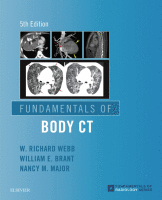Physical Address
304 North Cardinal St.
Dorchester Center, MA 02124

Multidetector CT (MDCT) is the imaging method of choice for the diagnosis of intra-abdominal injury following blunt abdominal trauma. Treatment is directed by characterization of the precise nature of the injury, or by the reliable demonstration of the absence of…

Peritoneal Cavity Anatomy The various recesses and spaces of the peritoneal cavity are easiest to recognize on CT when ascites is present. Identifying the precise compartment that an abnormality is in goes a long way toward identifying the nature of…

Despite marked advances in limiting image times for magnetic resonance imaging, CT remains the primary modality for most indications for imaging the abdomen and pelvis. The technology of multidetector CT (MDCT) scanners continues to advance, with progressive increases in the…

Technical Considerations In general, the pleura and chest wall are adequately evaluated with routine thoracic CT techniques. Contrast medium infusion is helpful in showing pleural thickening and in allowing its differentiation from pleural fluid. Soft-tissue window settings and bone windows…

On CT, normal lung varies in appearance, depending on the window settings used. With a window mean of –600 to –700 Hounsfield units (HU) and a width of 1000 to 1500 HU, the lungs appear dark, but not as black…

CT is helpful in the diagnosis of endobronchial lesions, hilar and parahilar masses, and hilar vascular lesions. Technique In most patients the hila are adequately assessed with spiral CT with a 5-mm slice thickness (it takes about 15 contiguous 5-mm…

Lymph Node Groups Mediastinal lymph nodes are generally classified by location. Most descriptive systems are based on a modification of Rouvière’s classification of lymph node groups. The names used in describing lymph nodes groups for the purpose of lung cancer…

Aortic Abnormalities Computed tomography (CT) is commonly used to diagnose abnormalities of the aorta or its branches when they are suspected clinically or because of radiographic abnormalities. Congenital Anomalies Congenital abnormalities of the aorta and its branches are readily diagnosed…

Computed tomography (CT) is commonly used in patients suspected of having a mediastinal mass or vascular abnormality (e.g., an aortic aneurysm). In general, CT is performed in two situations. First, in patients with a mediastinal abnormality visible on plain radiographs,…

S piral (helical) computed tomography (CT) allows the entire chest to be imaged in a few seconds or less (i.e., during a single breath hold), with volumetric acquisition of scan data. Two- and three-dimensional reformations may be performed if desired.…